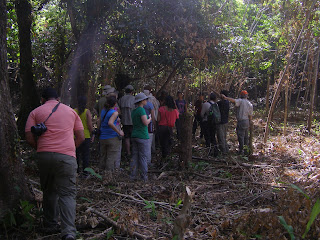This
weekend, on our way back from the Galeta Marine Lab, we took a side trip across
the Gatun Locks to a polyculture farm where they grow plantains and rice, as
well as corn. What's special about this farm is their understanding of the life
histories of plantains and rice and how they use it to minimize their pesticide
use while increasing crop yield.
Ships
waiting to leave the canal for the Caribbean
Walking to the plantation
Step
1: In the dry season, plant plantains.
Ready
for planting
Step
2: Wait until the plantains are about a foot tall, then burn the field!
Although this may sound crazy, the fire won’t damage the seeds under the ground,
and when the plantains grow back they will have significantly less pathogens.
Step
3: Wait a bit, then plant the rice.
This
staggering allows the plantains, which would naturally be outcompeted by rice,
to grow large enough that they aren’t outcompeted. As well, the plantain leaves
provide a shade canopy over the rice plants during the short dry spell around
May [veranico?] which would cause considerable damage to unshaded rice plants.
The biodiversity in the polyculture, especially since it is bordered by and
occasionally interspersed with natural forest, also helps to reduce pathogen
loads of each crop.
Thus,
by simply understanding the life histories, yield is increased without harmful
chemicals.
In the plantation learning its secrets
The view from the cornfield
Additionally:
by rotating crops, and including legumes and other nitrogen fixers between
rotations, the soil retains nutrients with minimal chemical fertilizers (such
as in monoculture).
Harvested rice
The
rice produced is primarily for the owner and workers, and sold to community
members; but a proportion (~30%) is sold in a market. The rice seed gathered
each year is also used primarily by the farm for the following year, but often
sold to friends and other community members.
And in
the nearby town of Achiote (where we stopped for lunch), we took the time to
visit a coffee museum and try out the traditional method of processing coffee
beans!
Coffee tree
Removing
the husks
Coffee beans drying









No comments:
Post a Comment